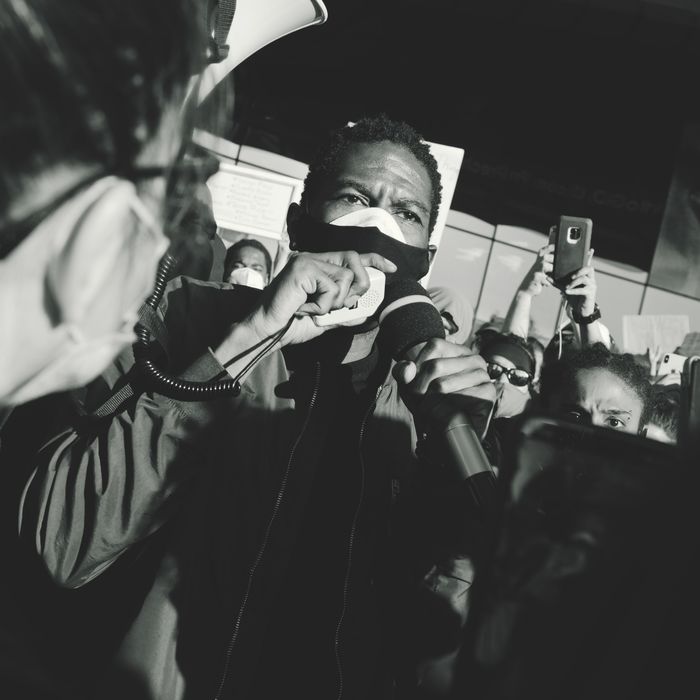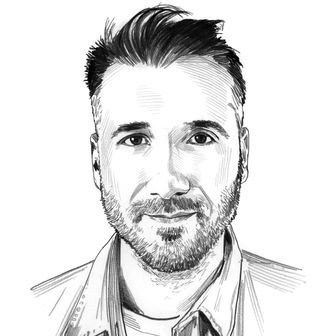
Jumaane Williams picked up his pace as he approached the entrance to the Manhattan Bridge early Sunday evening. He began to weave through the crowd of protesters, thousands of people peacefully marching along Brooklyn’s Flatbush Avenue, to see what — or who — was stopping the march at the front of the column at the base of the Manhattan Bridge. When Williams reached the intersection of Tillary and Flatbush, near the bridge entrance, he found protesters clashing with a mass of NYPD officers in riot gear, preventing the march from proceeding over the span.
Earlier in the day, the mayor’s office had told Williams, New York City’s public advocate, that the NYPD would be less aggressive on Sunday than it had been the past few nights, when city cops were recorded shoving peaceful protesters to the ground, running into protesters with patrol vehicles, and making large-scale arrests. But the scene at the foot of the Manhattan Bridge was the first on Sunday that had the potential to boil over.
An officer led Williams to Martine Materasso, chief of the NYPD’s counterterrorism bureau, who was standing on an island between the bridge’s on- and off-ramps, surrounded by police in riot gear. Williams hunched over so Materasso could hear him through his mask and appealed to her to allow the march to continue organically onto the Manhattan Bridge. Their conversation was unnecessary — as Materasso agreed to let the march continue onto the Manhattan-bound side of the bridge, a chorus of cheers went up from the column of protesters. They had already broken through the phalanx of officers and begun to ascend the ramp.
“Follow the black leadership!” Williams shouted, pointing toward the bridge. We rejoined the march and began walking up the bridge. “You have to let the crowd live its narrative,” Williams said, now strolling, answering text messages on his phone. “When the NYPD gets in the way, that’s when the trouble starts.” Williams had handled the delicate politics with the cops, even as the marchers had found their own path.
Williams, the second-highest-ranked elected official in the city, marched on Friday, Saturday, and Sunday. His presence was in stark contrast with Mayor Bill de Blasio, who seemed largely absent over the weekend, beyond making poorly received remarks that seemed to excuse NYPD violence. Before Sunday’s march, Williams addressed the protesters’ concerns, delivering a message that many had hoped to hear from the mayor: “Just because there are protesters, you do not have the right to mace people indiscriminately,” Williams shouted into a microphone during an impromptu speech. “You do not have the right to run over people!”
As public advocate, Williams’s power is limited. He has no official powers, and his budget is a mere $3.6 million. But the public advocate wields citywide influence from a meaningful bully pulpit. The position is often a stepping stone to greater things. Williams won the seat in a special election to replace Letitia James, who had been elected New York State attorney general in 2018. Before James, de Blasio held the office, which he used to push for public-housing reform — and set himself up for a mayoral run.
The son of Grenadian immigrants, Williams, 44, spent time as a community board member and tenant organizer before winning a seat on the City Council representing Brooklyn’s 45th District, which includes Flatbush, Marine Park, and Midwood, in 2009. A registered Democrat who is a self-described democratic socialist, Williams sometimes calls himself an “activist elected official” — a description he’s lived up to, getting arrested while protesting in 2017 and 2018. As a legislator, he made a name for himself as a vocal critic of stop and frisk. In 2013, he co-sponsored legislation to reduce police profiling and create an NYPD inspector general. Williams personally experienced the aggressive tactics that he challenged as a council member. In 2011, after he’d been on the City Council for two years, police officers handcuffed Williams during the West Indian American Day parade because he’d been walking on a closed-off sidewalk, despite the fact that an officer had allowed Williams to pass. When I asked Williams how the experience informed his work as public advocate, he shrugged, “I’ve been black a long time,” he said.
The most recent discussions around police reform in New York City have focused on repealing 50-A, a state law that shields police discipline records from the public, and cutting the department’s budget, which has outpaced the city’s overall spending for decades. COVID-19 has brought the latter issue into stark relief: The mayor’s most recent budget blueprint cut the Department of Youth and Community Development’s budget in half, while cutting a mere $24 million, or 0.4 percent, from the NYPD’s $6 billion budget.
“We expect there to be pain in the budget,” Williams said. “But it’s just not going to work if you strip every youth job while leaving the NYPD basically untouched. It’s just not going to work.” Like many New Yorkers, Williams has been bewildered by the latitude de Blasio, who was elected on a platform heavy on police reform, has offered the NYPD. “I’m still trying to figure out what happened,” Williams said. “More and more this administration is starting to sound like the last one.” As far as the budget goes, Williams is looking to the City Council to step in. He spent the first half of Sunday’s march alongside City Council Speaker Corey Johnson, who will be negotiating the budget with the mayor this month.
Johnson was one of many who walked alongside Williams on Sunday. John Liu, a state senator representing Queens, joined the public advocate for a while. Marchers introduced themselves to Williams to thank him for his work. A string of young black men told him that he was an inspiration. A friend from Brooklyn College tagged along. One police officer recognized Williams from the high-school Spanish class they shared at Brooklyn Tech. Another officer, wearing a kente-cloth mask, shouted out to Williams, who then jogged over to say hello. The officer was Edwin Raymond, a whistle-blower who, along with three other officers, sued the NYPD for racial discrimination in 2019, claiming their commander had told them to target black and brown people for arrest.
“He gets a lot of flak for that,” said Williams when he rejoined the march. “He gets it from both ends. People yelling at him now, and then he goes home, takes off his uniform, and he’s still a black man on the street in New York.”
Throughout the protest, Williams was in touch with Emma Wolfe, de Blasio’s chief of staff, letting her know how the march was going. Halfway across the Manhattan Bridge, Williams liked what he saw. The sun had just set and Williams’s security detail, dressed in a blue suit, was the only NYPD officer in sight. The public advocate paused to take a selfie with Spiderman. As the march reached Manhattan and continued peacefully across Canal Street, Williams pointed out that despite the gridlock, the only people laying on their horns were doing so in support of the protest. “You know New Yorkers hate traffic,” Williams said. “But look, everyone is calm.”
As we neared Church Street, NYPD vehicles raced past us. There was a standoff happening between the marchers and a group of police who had charged through the crowd and arrested one of the protesters. As we approached the intersection, Williams picked up the pace, just as he had near the Manhattan Bridge. By the time we reached the intersection, about 250 protesters were observing a moment of silence while kneeling in the middle of Canal Street, facing a line of cops three rows deep. Williams found his way to the thin trench between the protesters and riot shields, where once again he located the commanders on the scene. Williams huddled with the officers and a Black Lives Matter leader. Protesters watched in silence as the leaders shouted into each other’s ears, competing not with the din of chanting but with the whir of a police helicopter hovering above. Minutes later, the protesters stood and marched north into Soho. Another crisis averted.
“This was a tense moment. Some bottles were thrown,” said Williams, after calling Wolfe. He praised the young Black Lives Matter organizer who was talking with police, saying she helped deescalate the situation.
“I couldn’t sit there and let anything violent happen because I don’t want to see my people get hurt,” Brii, the BLM leader told me afterward. “I don’t want to see my people get arrested anymore. So I stood between the protesters and the police officers and tried my hardest to calm the protesters down.” For his part, Williams said he was trying to convince police to take a knee in solidarity with the protesters, but the NYPD did not oblige.
Shortly after the standoff, Williams decided to call it quits for the night. It was past 9 p.m., and he couldn’t remember how late he’d stayed on Friday and Saturday nights. His security detail was exhausted. There were moments of disruption and police aggression later in the night — an officer waved his gun at protesters, police pepper-sprayed and batoned protesters outside Barclays, and dozens of protesters were arrested after setting fires and breaking windows in Soho. Still, on Monday, the New York Post, often critical of Williams, praised the public advocate for “walking the streets of the city to keep them from succumbing to anarchist fury and criminality.” On MSNBC, Katy Tur asked Williams about the unrest in Soho the night before. Answering the question, Williams tried to retrain the focus on why people were protesting. “I feel like people are screaming that their leg is broken and everybody wants them to stop screaming without figuring out how to fix their leg,” Williams said. “Stop asking people to stop screaming when they are in true pain.”
































